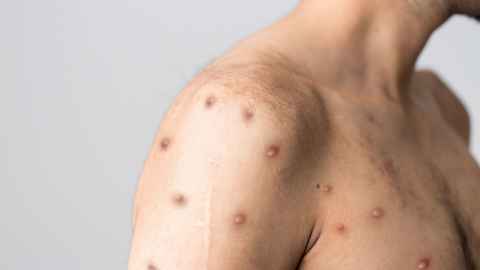Monkeypox: what it means for New Zealand
15 July 2022
Monkeypox has captured headlines. Mark Thomas explains its origins and what is likely to happen with the disease here.

Two people have been diagnosed with monkeypox in New Zealand in the last few days. In both cases, the men are likely to have acquired the infection overseas.
If the two men isolate at home and follow simple public health precautions they should recover completely in a fortnight or so and will not spread the disease. However, be prepared to see further cases.
The monkeypox virus is closely related to other viruses that have a long history of disease in humans. Smallpox was a major cause of severe disease and death from the time of the pharaohs. It was eradicated by immunisation with a vaccine that contained cowpox virus, which causes relatively mild disease in cows, horses, rodents, and cats.
Dairy maids with a history of cowpox were recognised to be immune to smallpox, which led to cowpox vaccination campaigns in many nations from 1800, and the eventual eradication of smallpox in 1977. The origin of smallpox is uncertain but is presumed to have been a virus that infected rodents in Africa thousands of years ago. The main source of cowpox is also rodents, and they occasionally infect cats, with humans the next step in the chain.
Monkey pox is closely related to cowpox and smallpox. Its natural hosts, in central and West Africa, include rodents. Human cases may occur as the result of people who touch the skin of infected wild rodents, or the skin of wild or domesticated animals that have been in contact with an infected rodent.
So the name is misleading because monkeys are not the usual hosts. They suffer infection in the same manner as humans. The virus was first identified in 1958 in monkeys in captivity in Denmark, with the first recognised human case in a child in the Democratic Republic of Congo in 1970.
Almost all patients with active monkeypox should be able to isolate at home. They should use precautions recommended for patients with Covid.
Infection is from contact either with the skin lesions of an infected animal or human, or with respiratory secretions contaminated by fluid leaking from sores inside the mouth. The virus has been identified in ejaculate, raising concern that it may be transmitted by genital fluids.
Following infection there is an asymptomatic incubation period that usually lasts one to two weeks. Next come headache, fever, muscle aches, tiredness and swollen lymph nodes. Sores will develop in the mouth. A few days later the rash or pox appears as scattered red patches on the skin.
Over the course of days each red patch progresses to become a swollen lump, which then forms a blister, that initially contains clear fluid which then becomes cloudy. The blister dries and the scab falls off.
The scattered patches appear in successive waves that usually appear first on the head, and the skin around the genitals, and then spread to the skin of the limbs, and then the hands and feet. The skin rash usually resolves after two to three weeks. Once the scabs have fallen off the person is no longer infectious. Diagnosis from symptoms is confirmed by PCR testing.
Monkeypox can be severe: approximately three percent of cases in Nigeria and approximately 10 percent of cases in the Democratic Republic of the Congo have been fatal. However, there have been fewer than 10 deaths in several thousand cases in the West.
Almost all patients with active monkeypox should be able to isolate at home. They should use precautions recommended for patients with Covid. It is especially important that skin to skin contact should be avoided. Contact with potentially contaminated clothing or bedding should be avoided, by using gloves and practising careful hand hygiene.
Cowpox vaccination, which until the 1960s was used to prevent smallpox, is effective in preventing monkeypox. More modern versions of this vaccine (such as ACAM2000 and JYNNEOS) have been developed and approved for use in humans, but their efficacy has not been extensively investigated. Two antiviral agents, Cidofovir and Tecovirimat have been approved for use, as has immune globulin purified from the blood of people who have received cowpox vaccination.
The present outbreak of monkeypox has resulted in more than 7,500 confirmed cases (at the time of writing), most of which have occurred in the the UK, US and Canada. The first case in this outbreak occurred in a British resident who had travelled to Nigeria and then returned to the UK on 4 May.
Subsequent cases have largely occurred in men who have sex with men, and many early cases appear to have been linked to attendance at a Gay Pride festival in the Canary Islands or a fetish festival in Belgium.
Given current knowledge it is difficult to predict the outcome of the epidemic in New Zealand. Strenuous public health efforts, alerting people to the features of the disease, encouraging testing to provide an early diagnosis, and recommending avoidance of risk behaviours by people with the disease may bring it under control. Alternatively, the disease may become established as a new sexually transmitted infection that also can be contracted by close non-sexual contacts.
Associate Professor Mark Thomas is an infectious diseases physician at the Faculty of Medical and Health Sciences, at the University of Auckland.
First published in Newsroom: What Monkeypox could mean for us
Media contact: Gilbert Wong, gilbert.wong@auckland.ac.nz